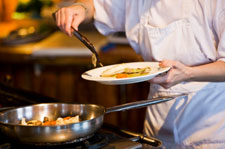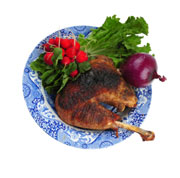Healthy Cooking for your Antiaging Program
Healthy cooking is as important to wellness as choosing the right foods eat. Certain cooking methods can seriously affect the nutrient content of your foods. Because minimal processing is the healthiest option, cooking healthy should be one of your top priorities.
Problems With Modern Cooking Methods

Primitive humans hunted and gathered their food for many thousands of years. There was no cooking back then, just eating of raw foods, animal flesh, fruits, berries, roots, ect. Not very appetizing, but then eating was about survival not gourmet cuisine!
Modern food processing is really about taste and shelf life. Healthy cooking on the other hand is about…well…HEALTH! When food is highly processed, the nutrients can be altered or destroyed, leaving the food less than healthy for consumption.
You should always try to strike a balance between taste, palatability and nutritional value. With that in mind, a few simple rules for cooking healthy should guide your efforts.
Below is a short list of cooking methods that have less than healthy results:
- Frying – involving the use of hydrogenated fats, or polyunsaturated oils
- Browning – heating foods until they turn brown due to glycosolation
- Cooking with polyunsaturated oils (corn, safflower, canola, ect.)
- Scrambling eggs vs soft boiling or poaching
- Grilling - (charcoal broiling) meats, chicken, or fish
- Overcooking foods (especially meats) but any protein food
- Microwaving – never EVER cook food this way, retire your microwave
Now I know how fond many people are of these cooking methods. I can hear the howls of protest going up already. But keep in mind this is just information I am giving you, and you will have to decide how to go about healthy cooking in YOUR kitchen.
One good thing about avoiding less healthy methods of cooking is that you can be cooking healthy on a budget, and thus eat healthier at the same time. Who says recessions don’t have a silver lining?
None of us are perfect in this sense. I do enjoy barbecue myself on occasion, but I keep it to a minimum, and never overcook my meats! Lets take a quick look at the chemistry of cooking methods to see why they pose a problem.
There IS an alternative to both the conventional and microwave oven. It cooks fast and in a healthy way, and it's called the Nuwave Oven. Check it out at this link: The Nuwave Oven
.
Heart Healthy Cooking
Fats are essential nutrients. They are very delicate substances on a molecular level. There are three types of fats:
- Saturated
- Monounsaturated
- Polyunsaturated
Saturated fats such as lard, and coconut oil (sometimes called palm oil) are the best fats to cook with because they tolerate high heat and remain stable at the molecular level. Cooking with coconut oil is probably your best bet IF you must cook using high temperatures.
Monounsaturated fats (olive oil) can be used in healthy cooking too, however cooking with olive oil should only be done at very low temperatures.
Polyunsaturated fats (vegetable oils, Crisco) should NEVER be used in cooking, because they oxidize (break down) at low temperatures giving off free radicals that cause many problems inside your body. Like what you ask? Like DNA damage (cancer), immune system dysfunction, heart disease, and inflammation (arthritis). These are all things you can do without!
Carbohydrates and Protein – The Problem of Denaturing and Glycation
Ok, enough of the big words. In simple terms when proteins are heated, their structure changes and they lose some of their nutrient value. I don’t know about you, but when I have to pay good money for quality meat, I don’t want it ruined by high cooking temps!
Glycation occurs when you cook at high temperatures and the protein molecules become bound to sugar. This creates what are called glycotoxins that increase free radical production and inflammation throughout your body.

This is why browning or high temperature cooking is something you should avoid. Of course this flies in the face of traditional cooking, but browning is absolutely NOT cooking healthy, so avoid it if you possibly can.
Microwaving
This method of cooking (if you can call it that) is an offshoot of radar technology. It is a wavelength of energy that rapidly vibrates the water molecules in your food, causing changes at the molecular level.
The Swedish were the first to research the effects of microwave-cooked foods on the human body. They found abnormalities in the blood of people in research studies that consumed foods prepared in microwave ovens.
Here is a link to some information about using microwaves for cooking that should make you rethink us of a microwave oven.
Microwave Oven and Microwave Cooking Overview
As regards microwaving I will make it simple, JUST SAY NO! You will be better off by avoiding this cooking method as it will alter your food at the molecular level and destroy its nutrient content. Microwaving is just NOT healthy cooking at all!
I replaced my microwave a few years ago with a Far Infrared oven, which I will cover in a separate page. Like the vegetable steamer, this is another must have item. Cooking healthy couldn’t be easier with this appliance. I LOVE IT!
Cooking Surfaces
Modern cooking surfaces such as Teflon do make cleaning easier because of their non-stick surface, however this appears to come at an increased health risk. So too the use of aluminum foil, and plastic wrap in cooking.
These substances are great for convenience but it comes at a cost, because all of these materials leach chemicals into your food that can cause health problems. Again, it will be up to you to decide whether the convenience they provide is worth risking your health.
Another issue in healthy cooking is cutting boards used in food preparation. Research has indicated that real wood is the preferred surface for cutting boards as it has a natural bacteria inhibiting effect, versus synthetic cutting surfaces. This shows once again that Mother Nature knows what she is doing!
Check out this informative website on cookware which covers this topic in much greater detail:
Raw Foods vs Healthy Cooking
Some wellness experts advocate a raw food diet as the best way to eat for maximum health. For what it’s worth I generally agree with this philosophy. However cooking does provide some protection from bacteria that can’t be ignored.
Ultimately it comes down to you using your best judgment. To avoid potential problems with food poisoning, I believe that meat, fish, and fowl should be definitely be cooked, but not overcooked.
Check into the correct times, temperatures, and healthy cooking methods for various animal proteins. Meat especially should NOT be overcooked, as this increases the risk of elevating Homocysteine levels by destroying important b-vitamins in the process.
Raw (unpasturized) milk involves minimal risk if it comes from an organic dairy farm where the cows are maintained in a healthy environment. Eggs can pose a problem if they are not cooked, but again, you will have to decide whether you want to take the risk.
Fruits and vegetables are best eaten raw, but need to be washed thoroughly, and rinsed with a food grade hydrogen peroxide/pure clean water mixture to ensure that you have killed surface bacteria.
You have to approach healthy cooking according to your personal needs and tastes. This page is just a guide, but you should always try to strike the best balance between enjoyment of your food and the healthiest way to prepare it.
Cooking healthy is essential to antiaging. Learn to integrate these principles into the way you prepare your meals, and you will look and feel better for it.
Return from Healthy Cooking to Antiaging Food
Return from Healthy Cooking to Longevity and Antiaging Secrets
New! Comments
Care to comment? Feel free to leave your comments below!